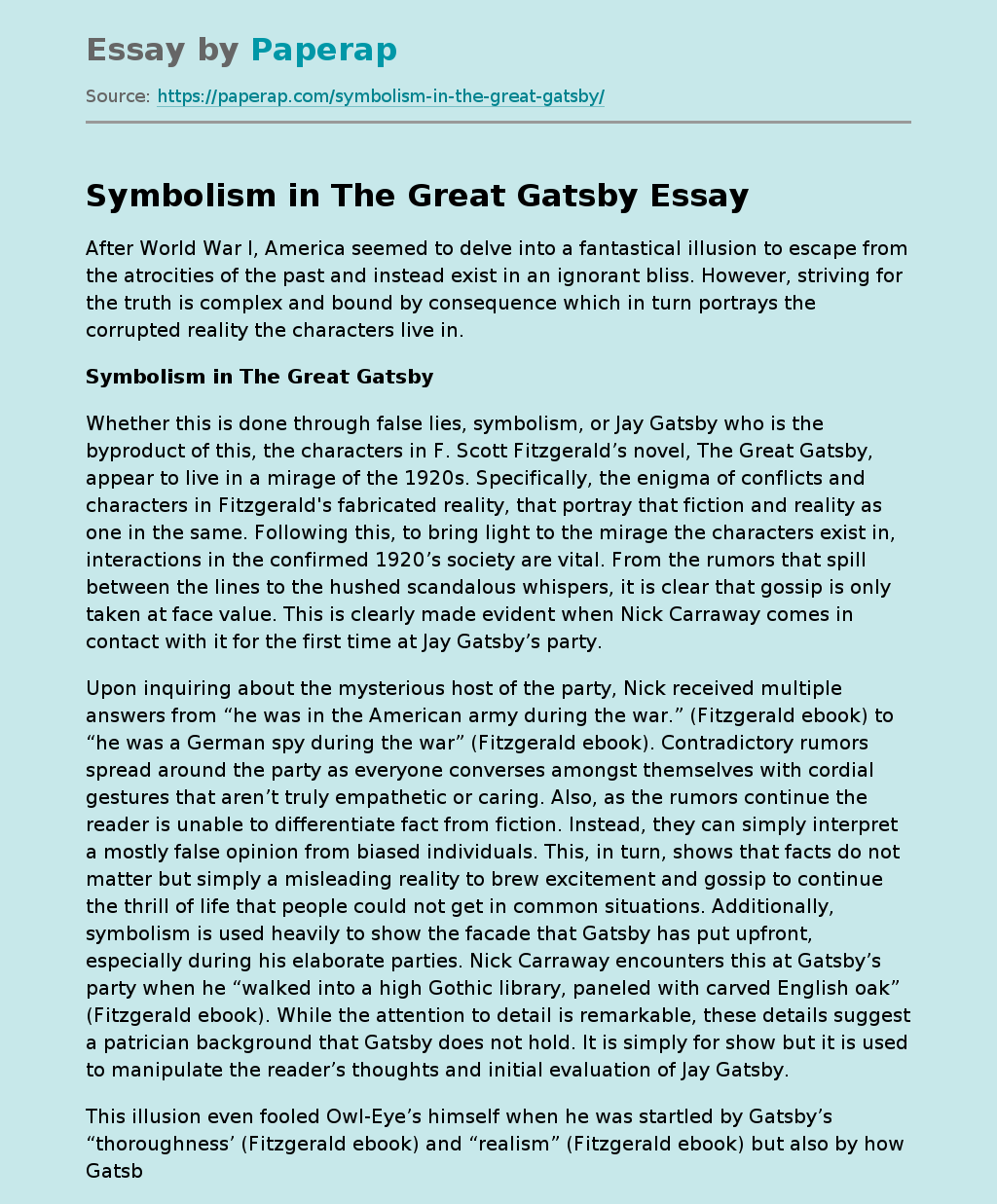Is America's Vision after WWI a Fantastical Illusion?
After World War I, America seemed to delve into a fantastical illusion to escape from the atrocities of the past and instead exist in an ignorant bliss. However, striving for the truth is complex and bound by consequence which in turn portrays the corrupted reality the characters live in.
Symbolism in The Great Gatsby
Whether this is done through false lies, symbolism, or Jay Gatsby who is the byproduct of this, the characters in F. Scott Fitzgerald’s novel, The Great Gatsby, appear to live in a mirage of the 1920s.
Specifically, the enigma of conflicts and characters in Fitzgerald’s fabricated reality, that portray that fiction and reality as one in the same. Following this, to bring light to the mirage the characters exist in, interactions in the confirmed 1920’s society are vital. From the rumors that spill between the lines to the hushed scandalous whispers, it is clear that gossip is only taken at face value. This is clearly made evident when Nick Carraway comes in contact with it for the first time at Jay Gatsby’s party.
Upon inquiring about the mysterious host of the party, Nick received multiple answers from “he was in the American army during the war.” (Fitzgerald ebook) to “he was a German spy during the war” (Fitzgerald ebook). Contradictory rumors spread around the party as everyone converses amongst themselves with cordial gestures that aren’t truly empathetic or caring. Also, as the rumors continue the reader is unable to differentiate fact from fiction.
Instead, they can simply interpret a mostly false opinion from biased individuals. This, in turn, shows that facts do not matter but simply a misleading reality to brew excitement and gossip to continue the thrill of life that people could not get in common situations. Additionally, symbolism is used heavily to show the facade that Gatsby has put upfront, especially during his elaborate parties. Nick Carraway encounters this at Gatsby’s party when he “walked into a high Gothic library, paneled with carved English oak” (Fitzgerald ebook). While the attention to detail is remarkable, these details suggest a patrician background that Gatsby does not hold. It is simply for show but it is used to manipulate the reader’s thoughts and initial evaluation of Jay Gatsby.
This illusion even fooled Owl-Eye’s himself when he was startled by Gatsby’s “thoroughness’ (Fitzgerald ebook) and “realism” (Fitzgerald ebook) but also by how Gatsby “didn’t cut the pages” (Fitzgerald ebook) of his books. That is because books used to come with their pages uncut. This means that the sheets that are folded to make the books aren’t sliced open on the top. A reader would have to cut them open before reading or else an individual would be able to tell if the book has been read before. This shows that Gatsby’s background is a lie. This background is simply used to get people to believe that he’s a man of great intellect, a graduate of Oxford, but in fact, this is far from the truth. The books though also symbolize Gatsby’s manifestation of himself but it lacks depth for it is a false fact based on lies, which in turn makes the illusion fragile. In a telling detail, Owl-Eyes who is presiding over Gatsby’s library shoves one of the books mumbling “that if one book was removed the whole library was liable to collapse” (Fitzgerald ebook). This persona, this mirage self Gatsby has constructed, is liable to collapse as well if one lie is removed and the truth revealed.
Furthermore, to reinforce the idea of lies being mistaken for reality, there is a labyrinth of characters that need to be observed. Specifically, Jay Gatsby and Nick Carraway. Gatsby is a complex and intricate character that strengthens his fragile facade by previously setting up his words to make a machiavellian initial impression upon people such as Nick, by “picking his words with care” (Fitzgerald ebook), furthering the textual evidence that Jay Gatsby is not real. Yet, people believe them. This in turn allows him to solidify his elusive self by using a dialect and vocabulary so advanced it “just missed being absurd” (Fitzgerald ebook). That is because he is trying to deceive Nick in thinking that he is not only sophisticated but intelligent. This makes Gatsby quite a chimerical character in the story.
On the other hand, there is also Nick, a rather controversial character but also the narrator of The Great Gatsby. Interestingly, Nick says that he is “inclined to reserve all judgment” (Fitzgerald ebook) but in fact, he does the opposite but still states that he is “one of the few honest people that I have ever known” (Fitzgerald ebook). He even states that this is his “cardinal virtue” (Fitzgerald ebook) and the four cardinal virtues are justice, prudence, temperance, and fortitude, as defined by Plato and Aristotle and adopted by the Church Fathers. This though is just a misconception for Nick honestly believes these lies even though they are faulty. In other words, he is an honest liar. Nick is very judgemental as well even though that takes effect in the aftermath of situations. Not to mention that fact that he acts as some kind of moral guide through a novel infused with lies and deception when he himself is made up of them for his is not entirely an ‘honest person’.
Сonclusion
Throughout the novel, F. Scott Fitzgerald portrays a society that is a hallucination of its true self, obstructing the reader from the veracity of the novel, through the paradox of conflicts and characters. If the characters and conflicts in The Great Gatsby come from words, rumors, and characters of contradiction, then a major theme of the novel is that no one in 1920’s America was free from a paradoxical reality and therefore illusion is mistaken for reality.
Is America's Vision after WWI a Fantastical Illusion?. (2021, Nov 11). Retrieved from https://paperap.com/symbolism-in-the-great-gatsby/

